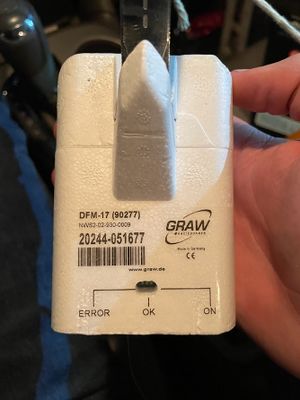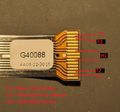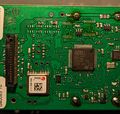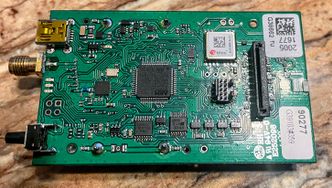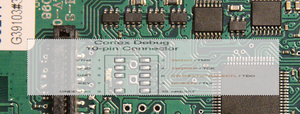Difference between revisions of "DFM-17 Radiosonde"
(Filling out IC table with U9-U12 information) |
m (Added additional IC information) |
||
| Line 60: | Line 60: | ||
!Part Marking | !Part Marking | ||
!Datasheet | !Datasheet | ||
| + | !Note | ||
|- | |- | ||
|U1 | |U1 | ||
| Line 68: | Line 69: | ||
|ARM 32F100R8T6B | |ARM 32F100R8T6B | ||
|[https://www.mouser.com/datasheet/2/389/stm32f100cb-1851080.pdf Mouser] | |[https://www.mouser.com/datasheet/2/389/stm32f100cb-1851080.pdf Mouser] | ||
| + | | | ||
|- | |- | ||
|U2, U3, U4, U5, U7 | |U2, U3, U4, U5, U7 | ||
| Line 76: | Line 78: | ||
|V719 | |V719 | ||
|[https://www.mouser.com/datasheet/2/389/stg719-1850635.pdf Mouser] | |[https://www.mouser.com/datasheet/2/389/stg719-1850635.pdf Mouser] | ||
| + | |''Analog ADG719 pin compatible equivalent?'' | ||
|- | |- | ||
|U6 | |U6 | ||
| Line 85: | Line 88: | ||
|636EE | |636EE | ||
|[https://www.mouser.com/datasheet/2/427/dg636e-1766306.pdf Mouser] | |[https://www.mouser.com/datasheet/2/427/dg636e-1766306.pdf Mouser] | ||
| + | | | ||
|- | |- | ||
|U8 | |U8 | ||
| Line 93: | Line 97: | ||
|LW053A | |LW053A | ||
|[https://www.ti.com/lit/ds/symlink/sn74lv4053a.pdf Texas Instruments] | |[https://www.ti.com/lit/ds/symlink/sn74lv4053a.pdf Texas Instruments] | ||
| + | | | ||
|- | |- | ||
|U9 | |U9 | ||
| Line 101: | Line 106: | ||
|C22A | |C22A | ||
|[https://www.ti.com/lit/ds/symlink/lmv762.pdf Texas Instruments] | |[https://www.ti.com/lit/ds/symlink/lmv762.pdf Texas Instruments] | ||
| + | | | ||
|- | |- | ||
|U10 | |U10 | ||
| Line 107: | Line 113: | ||
|High Performance, Low Current Transmitter | |High Performance, Low Current Transmitter | ||
| | | | ||
| − | |40632A C01Q81 | + | |40632A |
| + | C01Q81 | ||
| + | |||
| + | 2217 | ||
|[https://www.silabs.com/documents/public/data-sheets/Si4063-60-C.pdf Silcon Labs] | |[https://www.silabs.com/documents/public/data-sheets/Si4063-60-C.pdf Silcon Labs] | ||
| + | | | ||
|- | |- | ||
|U11 | |U11 | ||
| Line 117: | Line 127: | ||
|MAX-M8C-0-10 | |MAX-M8C-0-10 | ||
|[https://www.u-blox.com/sites/default/files/MAX-M8-FW3_DataSheet_%28UBX-15031506%29.pdf u-Blox] | |[https://www.u-blox.com/sites/default/files/MAX-M8-FW3_DataSheet_%28UBX-15031506%29.pdf u-Blox] | ||
| + | | | ||
|- | |- | ||
|U12 | |U12 | ||
| Line 127: | Line 138: | ||
|4BEB 8150 | |4BEB 8150 | ||
|[https://www.st.com/resource/en/datasheet/m24lr04e-r.pdf STMicroelectronics] | |[https://www.st.com/resource/en/datasheet/m24lr04e-r.pdf STMicroelectronics] | ||
| + | |''Needs verification'' | ||
|- | |- | ||
|U13 | |U13 | ||
| − | | | + | |STMicroelectronics |
| − | | | + | |LD series, ''unsure on specific part'' |
| − | | | + | |3.3V Low Drop Out Voltage Regulator |
| − | | | + | |DFN6 |
|33R | |33R | ||
| | | | ||
| + | |''Needs verification, appears to provide 3.3V for GNSS'' | ||
|- | |- | ||
|U14 | |U14 | ||
| Line 143: | Line 156: | ||
| | | | ||
| | | | ||
| + | |''Looks like a high side current monitor amplifier, need more information'' | ||
|- | |- | ||
|U15 | |U15 | ||
| + | |ABLIC | ||
| + | |S-8200A Series, ''unsure on specific Part Number'' | ||
| + | |BATTERY PROTECTION IC FOR 1-CELL PACK | ||
| | | | ||
| − | | | + | |VDL |
| − | | | + | |[https://www.mouser.com/datasheet/2/360/S8200A_E-1365901.pdf Mouser] |
| − | | | + | |''Needs verification, Potentially a Winsok WSTDW01 Battery Protection IC?'' |
| − | |||
| − | |||
|- | |- | ||
|U16 | |U16 | ||
| Line 159: | Line 174: | ||
| | | | ||
| | | | ||
| + | |''In-line with battery power, need more information; chip marking'' | ||
|- | |- | ||
|U17 | |U17 | ||
| Line 167: | Line 183: | ||
| | | | ||
| | | | ||
| + | |''Connected to USB data lines, likely a UART, isolation, and/or level shifter'' | ||
|} | |} | ||
<br /> | <br /> | ||
Revision as of 00:26, 17 January 2023
The DFM-17 is a balloon-launched radiosonde manufactured by GRAW Radiosondes GmbH & Co. KG, and used for meteorological sounding.
Contents
Overview
The DFM-17 radiosonde succeeds the DFM-09 radiosonde. Graw began a contract with NOAA in the US to provide radiosondes. As of Late 2021, several sites have made the transition as part of NOAA’s Operational Test and Evaluation (OT&E) program. 45 CONUS sites are expected to use these radiosondes in early 2022. [1]
Specs [2]
- Weight: 63g
- Size: 90 x 67 x 44 mm
- Power supply: 2 CR123A batteries
- Estimated runtime: ~240 minutes
- Transmission rate: 1 packet/sec
- Bandwidth: ~10 kHz (Website lists <12)
- Frequency range: 400 - 405.99 MHz
- Modulation: GFSK
- TX Power: ~100mW
- Error Correction: Code-spreading, interleaving
- SoC: STM32F100R8T6B, 24MHz, 8KB RAM, 64KB Flash
- GPS: U-Blox MAX-M8C-0-10
- Transmitter: Si4063
Peripheral attachment points
LED's and Buttons
- Button = PC8
- LED_Y = PC7
- LED_G = PC6
- LED_R = PB12
GPS
- PA3(RX) = GPS TXD
- PA2(TX) = GPS RXD
UART via USB Port
- PA9(TX) = USB D+
- PA10(RX) = USB D-
Si4063
- PB2 = CS/nSEL
- PA7 = SDI
- PA6 = SDO
- PA5 = SCLK
Identified Supplementary IC's
| Manufacturer | Part Number | Description | Package | Part Marking | Datasheet | Note | |
|---|---|---|---|---|---|---|---|
| U1 | STMicroelectronics | STM32F100R8T6B | ARM MCU, 24MHz, 8KB RAM, 64KB Flash | ARM 32F100R8T6B | Mouser | ||
| U2, U3, U4, U5, U7 | ST | STG719 | STG719STR Low Voltage 4 Ohm SPDT Switch | SOT-23-6 | V719 | Mouser | Analog ADG719 pin compatible equivalent? |
| U6 | Vishay | DG636E | 0.3 pC Charge Injection, 100 pA Leakage
CMOS ± 5 V / 5 V / 3 V Dual SPDT Analog Switch |
636EE | Mouser | ||
| U8 | Texas Instruments | SN74LV4053A | Triple 2-Channel Analog Multiplexer/Demultiplexer | SOT-23-6 | LW053A | Texas Instruments | |
| U9 | Texas Instruments | LMV761 | Low Voltage Precision Comparator with Push/Pull Output | C22A | Texas Instruments | ||
| U10 | Silicon Labs | Si4063 | High Performance, Low Current Transmitter | 40632A
C01Q81 2217 |
Silcon Labs | ||
| U11 | u-Blox | MAX-M8C-0-10 | u-blox M8 GNSS module, ROM, crystal | MAX-M8C-0-10 | u-Blox | ||
| U12 | STMicroelectronics | M24LR04E-R | Dynamic NFC/RFID tag IC with 4-Kbit EEPROM,
energy harvesting, I²C bus and ISO 15693 RF interface |
TSSOP8 (DW) | 4BEB 8150 | STMicroelectronics | Needs verification |
| U13 | STMicroelectronics | LD series, unsure on specific part | 3.3V Low Drop Out Voltage Regulator | DFN6 | 33R | Needs verification, appears to provide 3.3V for GNSS | |
| U14 | Looks like a high side current monitor amplifier, need more information | ||||||
| U15 | ABLIC | S-8200A Series, unsure on specific Part Number | BATTERY PROTECTION IC FOR 1-CELL PACK | VDL | Mouser | Needs verification, Potentially a Winsok WSTDW01 Battery Protection IC? | |
| U16 | In-line with battery power, need more information; chip marking | ||||||
| U17 | Connected to USB data lines, likely a UART, isolation, and/or level shifter |
Photos
Possible meanings of the internal labels and values. The date code in particular which may be useful to date production times. NWS sondes have the same cryptic string printed on the outside of the sonde where the mfg. date normally is on other countries'. "TU" may just indicate the board comes with sensors according to a third party source[3].
Disassembly
- Examine rope, parachute and parachute rigging lines for viability. Neatly organize the flight rigging if usable. Discard if not viable for reuse.
- Cut the zip tie surrounding the Styrofoam from the top portion by the rope loop.
- Pull the rope loop out, there should be little to no resistance.
- Make a slice in the sticker[4] where the two pieces of Styrofoam meet.
- Pull apart the two Styrofoam pieces to reveal the circuit board.
- Pull the circuit board out. There will be some resistance.
- The board is now separated from the Styrofoam shell, reuse if desired.
- Pull the two CR123A batteries out, keep or discard them. The board can run off USB power. Batteries are not necessary for development on this board.
Reassembly
- Insert two fresh CR123A batteries into the board.
- Line up the board to the IO cutouts in the Styrofoam, begin to push into the slots. Make sure the antenna wire comes through.
- Press the top piece of Styrofoam into place.
- Tape or apply another sticker onto the back label. (Optional)
- Insert the plastic rope loop piece.
- zip tie the shell together, the zip tie end should end up on the edge nearest to the power button.
- Rope on a balloon/drone/kite/etc.. to the rope loop.
- Power on the device by pressing and holding the button, you will see a yellow light blink, hold until the light turns solid.
Mini USB Port
The mini USB port on the board does not use the USB protocol for communication, it is a UART bus. However using USB to power the board should not harm the board in theory.
In order to use it, splice a USB cable and wire up a USB<->TTL adapter with the following pins:
- VBUS: 5 Volts DC
- D-: TX
- D+: RX
- GND: GND
The board will communicate with the official GRAWMET software using this approach. Reverse engineering of the port's protocol is underway, however it is believed to use a similar, if not the same protocol the PS-15 uses.
Hardware modifications
The DFM-17 has solder pads for an SMA port and a SWD header.
An Adafruit Skinny SWD SMT connector and a generic SMA connected was used in the photo.
Developing and Programming the board
When lab testing, you can power the board from the USB header. It also appears to run fine supplying 3.3V to the SWD port(STLink clones do this).
The board uses a STM32, and requires a ST-Link to program. The process used to upload code to the MCU is the same as the Vaisala RS41 radiosonde, you will need to solder and connect the VTRef(3.3V), Ground, SWDIO, SWDCLK and RST pins to your ST-Link.
The board can run without external power being supplied when programming. This board has read-out protection enabled similar to the RS41 and this must be disabled before you can flash firmware to the board.
- ↑ GRAW delivers to USA NOAA/National Weather Service. GRAW Radiosondes GmbH & Co. KG. Retrieved 17 November 2021.
- ↑ https://www.graw.de/products/radiosondes/dfm-17/
- ↑ https://sondehunt.de/language/en/archive/1189
- ↑ File:DFM-17 NOAA Label.jpg
